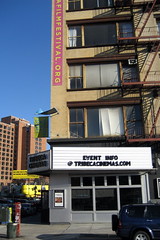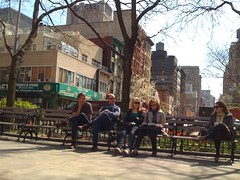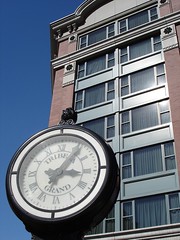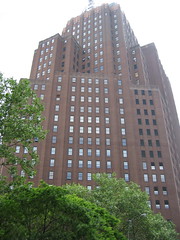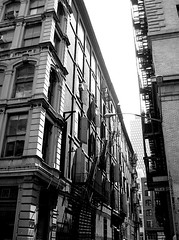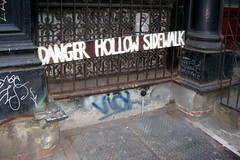South:
36 (corner): Pompanoosuc Mills, a Vermont furniture showroom,
is in an award-winning 2001 condo building
known as
124 Hudson Street, whose materials and design
reflect its late 19th Century Romanesque Revival neighbors.
John Ericcson, the naval engineer
who designed the ironclad Monitor, lived
at this Beach Street address from 1864--two years after his creation sank
the Merrimac--until his death in 1889.

16 (corner):
NYPD's 1st Precinct covers all of Manhattan
south of the Brooklyn Bridge, plus everything
south of Houston and west of Broadway. There
was one murder in this area in 2004. The building
dates to 1912 (when this was the 4th Precinct),
a Renaissance Revival landmark by Hoppin & Koen.
|
|
|
North:
Hudson Square
Once known as St. John's Park, this
place was described by the New York
Evening Post in 1847 as a ''spot of eden
loveliness...retiring from the
din and tumult of the noisy town to enjoy
its own secret solitude.'' Then, in 1869, it
was sold by Trinity Church to Commodore
Vanderbilt for a railroad terminal, and in
1927 it became the rotary that the Holland
Tunnel emerges into.
From 1807 until 1918 there was a church,
St. John's Chapel, on the Varick Street side.
|
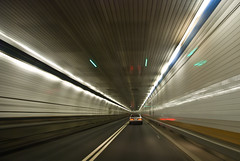
The Holland Tunnel, con- necting Man- hattan
to Jersey City, was started in 1922
and completed in 1927, allowing cars to drive
into New York City from New Jersey for the
first time. Though the name evokes New York City's
Dutch heritage, it actually honors Clifford Milburn Holland,
chief engineer of the project, who died on October
7, 1924, the day
before the tunnels dug from New York and New Jersey
were connected.
The project was completed by famed
tunnel designer Ole Singstad, whose pioneering
ventilation system allowed the Holland Tunnel to be
the first vehicular tunnel of substantial length.
On I Love Lucy, Lucy is said to have made
U-turn in the Holland Tunnel, tying up traffic all the
way to East Orange. The mutant insect in The Deadly
Mantis is killed here with nerve gas. |
|


